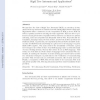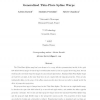IANDC
2011
13 years 4 months ago
2011
We introduce the class of Rigid Tree Automata (RTA), an extension of standard bottom-up automata on ranked trees with distinguished states called rigid. Rigid states define a res...
CORR
2011
Springer
13 years 4 months ago
2011
Springer
In this paper, we develop new methods for the analysis of decentralized control systems and we apply them to formation control problems. The basic set-up consists of a system with...
CVPR
2011
IEEE
13 years 4 months ago
2011
IEEE
We present a novel probabilistic framework for rigid tracking and segmentation of shapes observed from multiple cameras. Most existing methods have focused on solving each of thes...
INFOCOM
2010
IEEE
13 years 7 months ago
2010
IEEE
A fundamental problem in wireless ad
IJCV
2010
13 years 7 months ago
2010
The Thin-Plate Spline warp has been shown to be a very effective parameterized model of the optic flow field between images of various types of deformable surfaces, such as a p...
IJCV
2002
13 years 9 months ago
2002
In this paper we explore a multiple hypothesis approach to estimating rigid motion from a moving stereo rig. More precisely, we introduce the use of Gaussian mixtures to model cor...
ICRA
2002
IEEE
14 years 2 months ago
2002
IEEE
We develop a method for generating smooth trajectories for a set of mobile robots. Given two end configurations, by tuning one parameter, the user can choose an interpolating tra...


